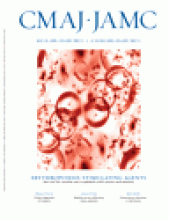Abstract
Background: Primary care reform in Ontario, Canada, included the initiation of a blended capitation model in 2001–2002 and an enhanced fee-for-service model in 2003. Both models involve patient rostering, incentives for preventive care and requirements for after-hours care. We evaluated practice characteristics and patterns of care under both models.
Methods: Using administrative data, we identified physicians belonging to either the capitation or the enhanced fee-for-service group throughout the period from Sept. 1, 2005, to Aug. 31, 2006, and their enrolled patients. Practices were stratified by location (urban v. rural). We compared the groups in terms of practice characteristics and patterns of care, including comprehensiveness of care, continuity of care, after-hours care, visits to the emergency department and uptake of new patients.
Results: Patients in the capitation and enhanced fee-for-service practices had similar demographic characteristics. Patients in capitation practices had lower morbidity and comorbidity indices. Comprehensiveness and continuity of care were similar between the 2 groups. Compared with patients in enhanced fee-for-service practices, those in capitation practices had less after-hours care (adjusted rate ratio [RR] 0.68, 95% confidence interval [CI] 0.61–0.75) and more visits to emergency departments (adjusted RR 1.20, 95% CI 1.15–1.25). Overall, physicians in the capitation group enrolled fewer new patients than did physicians in the enhanced fee-for-service group (37.0 v. 52.0 per physician); the same was true of new graduates (60.3 v. 72.1 per physician).
Interpretation: Physicians enrolled in the capitation model had different practice characteristics than those in the enhanced fee-for-service model. These characteristics appeared to be pre-existing and not due to enrolment in a new model. Although the capitation model provides an alternative to fee-for-service practice, its characteristics should be the focus of future policy development and research.











